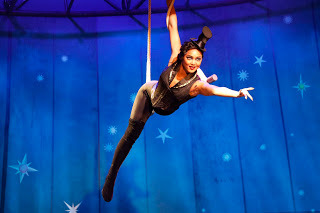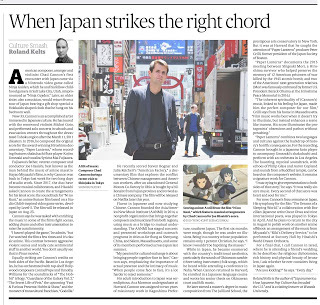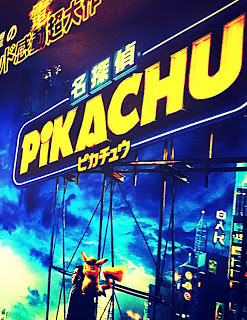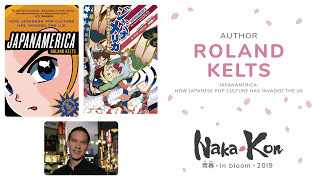Roland Kelts's Blog, page 18
June 25, 2019
My take on Broadway's PIPPIN produced in JAPAN
Published on June 25, 2019 04:19
June 4, 2019
Hiroshima and Hayao Miyazaki: America's musician for Studio Ghibli
Published on June 04, 2019 04:05
May 16, 2019
My interview for NPR on "Detective Pikachu," the first Hollywood live-action Pokemon movie
Published on May 16, 2019 10:32
May 7, 2019
My hero, ULTRAMAN, hits Netflix as anime
New 'Ultraman' anime is a family affair
 The Japan Times
The Japan Times
I first met anime director and mechanical designer Shinji Aramaki in Tokyo 12 years ago. He had just completed “Appleseed: Ex Machina,” the second in a trio of epic CG-animated films based on Masamune Shirow’s four-volume 1985 manga.
“Ex Machina” was a global collaboration: co-produced by Hong Kong/Hollywood director John Woo, costumed by Italy’s Miuccia Prada and scored by Yellow Magic Orchestra’s Haruomi Hosono.
Since then, Aramaki has become anime’s go-to guy for Japanese franchise reboots and sequels targeting international markets. As the nation’s domestic audience ages and its youth population shrinks, producers are scrambling to dust off older titles that might resonate both at home and abroad. That has them going to Aramaki a lot.
Now 58 and the father of two adult daughters, he is currently working alongside screenwriter/director Kenji Kamiyama on anime adaptations of 1989’s “Ghost in the Shell” for Netflix and 1982’s “Blade Runner” for Cartoon Network and Crunchyroll.
Last month, Netflix released the duo’s anime version of “Ultraman,” based on a 2011 manga that was a continuation of the classic long-running tokusatsu (special effects) TV series, which debuted in 1966. Ultraman and his brethren (the Ultra Brothers) are alien beings that descend to earth and merge with a human to help the Japanese branch of the Science Patrol battle exotic monsters bent on destruction.
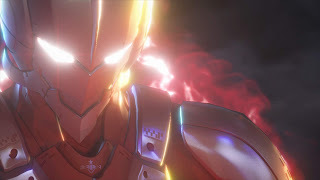 Netflix 2019
Netflix 2019
The legendary Eiji Tsuburaya (1901-70) of “Godzilla” fame created the original live-action TV show, the first in Japan to be exported. Over the past five decades the Ultraman brothers became ubiquitous in Japan and other parts of Asia through posters, costumes, T-shirts, toys and adverts for products ranging from Honda vehicles to Hawaiian vacations. Ultraman merchandise alone generates over $50 million (¥5.5billion) a year in Japan.
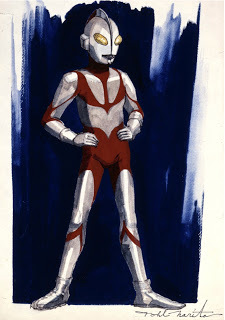 Kyodo 1966
Kyodo 1966
The 13 CG-animated episodes released on Netflix are loaded with fights, replacing the TV series’ “suitmation” (actors wrestling in rubber suits) with digital motion-capture footage. But the focus is on the heroes’ inter-generational dynamics — more psychodrama than monster-of-the-week.
Read >>
 The Japan Times
The Japan TimesI first met anime director and mechanical designer Shinji Aramaki in Tokyo 12 years ago. He had just completed “Appleseed: Ex Machina,” the second in a trio of epic CG-animated films based on Masamune Shirow’s four-volume 1985 manga.
“Ex Machina” was a global collaboration: co-produced by Hong Kong/Hollywood director John Woo, costumed by Italy’s Miuccia Prada and scored by Yellow Magic Orchestra’s Haruomi Hosono.
Since then, Aramaki has become anime’s go-to guy for Japanese franchise reboots and sequels targeting international markets. As the nation’s domestic audience ages and its youth population shrinks, producers are scrambling to dust off older titles that might resonate both at home and abroad. That has them going to Aramaki a lot.
Now 58 and the father of two adult daughters, he is currently working alongside screenwriter/director Kenji Kamiyama on anime adaptations of 1989’s “Ghost in the Shell” for Netflix and 1982’s “Blade Runner” for Cartoon Network and Crunchyroll.
Last month, Netflix released the duo’s anime version of “Ultraman,” based on a 2011 manga that was a continuation of the classic long-running tokusatsu (special effects) TV series, which debuted in 1966. Ultraman and his brethren (the Ultra Brothers) are alien beings that descend to earth and merge with a human to help the Japanese branch of the Science Patrol battle exotic monsters bent on destruction.
 Netflix 2019
Netflix 2019The legendary Eiji Tsuburaya (1901-70) of “Godzilla” fame created the original live-action TV show, the first in Japan to be exported. Over the past five decades the Ultraman brothers became ubiquitous in Japan and other parts of Asia through posters, costumes, T-shirts, toys and adverts for products ranging from Honda vehicles to Hawaiian vacations. Ultraman merchandise alone generates over $50 million (¥5.5billion) a year in Japan.
 Kyodo 1966
Kyodo 1966The 13 CG-animated episodes released on Netflix are loaded with fights, replacing the TV series’ “suitmation” (actors wrestling in rubber suits) with digital motion-capture footage. But the focus is on the heroes’ inter-generational dynamics — more psychodrama than monster-of-the-week.
Read >>
Published on May 07, 2019 09:14
May 1, 2019
April 17, 2019
Japan's "virginity crisis"
Virgin territory: why the Japanese are turning their backs on sex
 The GuardianYoung people in Japan – particularly men – are shunning physical love, and they’re not the only ones
The GuardianYoung people in Japan – particularly men – are shunning physical love, and they’re not the only ones
The grounds of Tokyo’s Yoyogi Park have been colonised by beautiful youth: women and men beneath the cherry blossoms surrounded by bottles of wine, sake and shochu, cases of beer and plastic bags stuffed with finger foods – drinking, playing games and sharing smartphone screens as the buds bloom and fall.
Hanami (flower-viewing) parties are a centuries-old rite of spring, a national symbol of life’s beauty and brevity. But as I walk by them this month, I can’t help but wonder if any of the pink-faced revellers are hooking up, or even care enough to try.
“Sexless Japan” is now a reliable media meme. Bolstered by a plummeting birth rate and an ageing population (leading to dire predictions of a future Japan devoid of Japanese), this portrait of the nation’s celibate society has been further enhanced by a paradox: Japan’s cultural imagination is embedded with erotic imagery, from 17th-century shunga woodblock prints to what non-Japanese today often mistakenly call hentai (perverse) pornographic manga and anime. The sex lives of the Japanese, the story goes, have been almost entirely sublimated.
I once wrote about this phenomenon (sekkusu-banare, drifting away from sex) in these pages, and talked about it in a BBC documentary called No Sex Please, We’re Japanese . Both times I was careful to imply what is now obvious: it isn’t just happening in Japan.
Read >>
 The GuardianYoung people in Japan – particularly men – are shunning physical love, and they’re not the only ones
The GuardianYoung people in Japan – particularly men – are shunning physical love, and they’re not the only onesThe grounds of Tokyo’s Yoyogi Park have been colonised by beautiful youth: women and men beneath the cherry blossoms surrounded by bottles of wine, sake and shochu, cases of beer and plastic bags stuffed with finger foods – drinking, playing games and sharing smartphone screens as the buds bloom and fall.
Hanami (flower-viewing) parties are a centuries-old rite of spring, a national symbol of life’s beauty and brevity. But as I walk by them this month, I can’t help but wonder if any of the pink-faced revellers are hooking up, or even care enough to try.
“Sexless Japan” is now a reliable media meme. Bolstered by a plummeting birth rate and an ageing population (leading to dire predictions of a future Japan devoid of Japanese), this portrait of the nation’s celibate society has been further enhanced by a paradox: Japan’s cultural imagination is embedded with erotic imagery, from 17th-century shunga woodblock prints to what non-Japanese today often mistakenly call hentai (perverse) pornographic manga and anime. The sex lives of the Japanese, the story goes, have been almost entirely sublimated.
I once wrote about this phenomenon (sekkusu-banare, drifting away from sex) in these pages, and talked about it in a BBC documentary called No Sex Please, We’re Japanese . Both times I was careful to imply what is now obvious: it isn’t just happening in Japan.
Read >>
Published on April 17, 2019 20:35
April 11, 2019
Donald Keene, 1922 - 2019
Writers recall their initiation to Japanese literature via Donald Keene
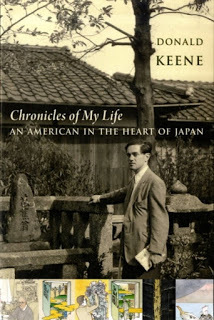
Roland Kelts, author:
Bookforum asked me to review Donald Keene’s memoirs, “Chronicles of My Life: An American in the Heart of Japan.”
I said yes and winced. Keene was in his 80s at the time and had a lot of life to remember. His book would be massive. But then he, too, was vast: a bridge from my America to my Japanese mother’s land and literature. Also, a graduate of and professor emeritus at my alma mater, Columbia University, whose Center of Japanese Culture bears his name.
A slim package arrived: 200 pages. In one chapter, Keene jet-sets around Europe, lobbying for Mishima’s Nobel, when his mother falls ill in New York. He arrives at her bedside too late. She can no longer speak.
One cannot live and love in two worlds at once, he observes. The chapter closes so softly I had to put the book down and stare at the wall, shaken.
Keene did what Kafka asks of writers: Ax the frozen sea within us.
Read >>

Roland Kelts, author:
Bookforum asked me to review Donald Keene’s memoirs, “Chronicles of My Life: An American in the Heart of Japan.”
I said yes and winced. Keene was in his 80s at the time and had a lot of life to remember. His book would be massive. But then he, too, was vast: a bridge from my America to my Japanese mother’s land and literature. Also, a graduate of and professor emeritus at my alma mater, Columbia University, whose Center of Japanese Culture bears his name.
A slim package arrived: 200 pages. In one chapter, Keene jet-sets around Europe, lobbying for Mishima’s Nobel, when his mother falls ill in New York. He arrives at her bedside too late. She can no longer speak.
One cannot live and love in two worlds at once, he observes. The chapter closes so softly I had to put the book down and stare at the wall, shaken.
Keene did what Kafka asks of writers: Ax the frozen sea within us.
Read >>
Published on April 11, 2019 03:16
April 4, 2019
#Metoo meets #anime
#MeToo allegations roil U.S. anime conventions
 The Japan Times
The Japan Times
Over the past few months, the #MeToo movement breached the American anime convention industry. Most feel it was inevitable. Many say it’s about time.
The first salvo was fired in mid-January in the form of a Twitter thread accusing veteran American voice actor Vic Mignogna (“Dragon Ball Z,” “Fullmetal Alchemist”) of homophobia, anti-Semitic behavior and unwanted sexual contact.
Soon the charges from fans, some of whom claim they were underage at the time of the alleged transgressions, were joined by those from con staff members, professional cosplayers, fellow voice actors and an ex-fiancee.
Less than a week after the first tweets dropped, Mignogna released a public statement rejecting accusations of bigotry, proclaiming the innocence of his intentions and apologizing to anyone who felt violated by his “show (of) gratitude or support.” He has not been formally charged with anything.
Some Twitter users, including those in the actor’s fan club, aggressively defended Mignogna. The hashtags proliferated: #istandwithvic (for) and #kickvic (against), and now, #vickkicksback (anti-against).
The controversy expanded on Jan. 30, when an article appeared on the Anime News Network (ANN) site, one of the largest English-language industry portals. Its headline, “Far From Perfect,” was borrowed from Mignogna’s personal apologia to his fan club members.
 Lynzee Loveridge
Lynzee Loveridge
Lynzee Loveridge, ANN’s managing interest editor, compiled firsthand accounts, mostly anonymous, from a handful of fans and one cosplayer, all of whom felt mistreated, insulted or physically victimized by Mignogna’s actions. ANN also published photos of the actor embracing young autograph seekers. The article consolidated and at least partially legitimized the social media posts.
Read >>
 The Japan Times
The Japan TimesOver the past few months, the #MeToo movement breached the American anime convention industry. Most feel it was inevitable. Many say it’s about time.
The first salvo was fired in mid-January in the form of a Twitter thread accusing veteran American voice actor Vic Mignogna (“Dragon Ball Z,” “Fullmetal Alchemist”) of homophobia, anti-Semitic behavior and unwanted sexual contact.
Soon the charges from fans, some of whom claim they were underage at the time of the alleged transgressions, were joined by those from con staff members, professional cosplayers, fellow voice actors and an ex-fiancee.
Less than a week after the first tweets dropped, Mignogna released a public statement rejecting accusations of bigotry, proclaiming the innocence of his intentions and apologizing to anyone who felt violated by his “show (of) gratitude or support.” He has not been formally charged with anything.
Some Twitter users, including those in the actor’s fan club, aggressively defended Mignogna. The hashtags proliferated: #istandwithvic (for) and #kickvic (against), and now, #vickkicksback (anti-against).
The controversy expanded on Jan. 30, when an article appeared on the Anime News Network (ANN) site, one of the largest English-language industry portals. Its headline, “Far From Perfect,” was borrowed from Mignogna’s personal apologia to his fan club members.
 Lynzee Loveridge
Lynzee LoveridgeLynzee Loveridge, ANN’s managing interest editor, compiled firsthand accounts, mostly anonymous, from a handful of fans and one cosplayer, all of whom felt mistreated, insulted or physically victimized by Mignogna’s actions. ANN also published photos of the actor embracing young autograph seekers. The article consolidated and at least partially legitimized the social media posts.
Read >>
Published on April 04, 2019 21:32
February 24, 2019
Haruki Murakami at 70: my latest interview
Still swinging for the fences: Murakami in conversation

“You see, I’m like a cat”, he tells me, twice. “I know the best position, and I go there straight. And I do it on my own time. Many people don’t like that about me.”
Read >>

“You see, I’m like a cat”, he tells me, twice. “I know the best position, and I go there straight. And I do it on my own time. Many people don’t like that about me.”
Read >>
Published on February 24, 2019 07:19
February 16, 2019
NAKA-KON 2019
Published on February 16, 2019 23:17

